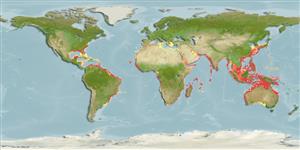(كوسه ها و سپرماهيان) (sharks and rays) >
Carcharhiniformes (Ground sharks) >
Carcharhinidae (Requiem sharks)
Etymology: Carcharhinus: karcharos (Gr.), sharp or jagged; rhinus, an ancient name for sharks, from rhine (Gr.), rasp, both words alluding to a shark's jagged, rasp-like skin. (See ETYFish); brevipinna: brevis (L.), short; pinna (L.) fin, referring to small pectoral and first dorsal fins. (See ETYFish).
Environment: milieu / climate zone / depth range / distribution range
بوم شناسي
دريايي وابسته به آب سنگ; اقیانوس رو (Ref. 51243); تغييرات عمق 0 - 100 m (Ref. 27000), usually 0 - ? m (Ref. 55179). Subtropical; 40°N - 38°S, 100°W - 155°E (Ref. 55179)
Atlantic, Mediterranean and Indo-West Pacific, warm temperate and tropical (Ref. 58085). Often referred to as Carcharhinus limbatus in the past.
Length at first maturity / Size / Weight / سن
Maturity: Lm 205.8, range 170 - 266 cm
Max length : 300 cm TL جنس نر / بدون خواص جنسي; (Ref. 26999); common length : 250 cm TL جنس نر / بدون خواص جنسي; (Ref. 30573); بيشينه وزن گزارش شده: 89.7 kg (Ref. 40637); بيشينه سن گزارش شده: 16 سال ها (Ref. 127272)
خارهاي باله پشتي (کل): 0; شعاع نرم باله پشتي (کل): 0; خارهاي باله مخرجي 0; شعاع نرم باله مخرجي: 0. A slender shark with a long, narrow, pointed snout, long gill slits and small, narrow-cusped teeth; first dorsal fin small; no interdorsal ridge; labial furrows longer than in any other grey shark (Ref. 5578). Grey above, white below, with a conspicuous white band on sides; second dorsal, anal, undersides of pectorals and lower caudal-fin lobe black or dark grey-tipped in subadults and adults, but unmarked or nearly so in small individuals (Ref. 9997).
Found on the continental and insular shelves from close inshore to offshore (Ref. 244). Makes vertical spinning leaps out of the water as a feeding technique in which the sharks spins through a school of small fish with an open mouth and then breaks the surface (Ref. 9997). Feeds mainly on pelagic bony fishes, also small sharks, cuttlefish, squids, and octopi (Ref. 244, 5578). Viviparous (Ref. 50449). Forms schools (Ref. 244). Highly migratory off Florida and Louisiana and in the Gulf of Mexico (Ref. 244). Regularly caught in fisheries where found (Ref. 244). Utilized fresh and dried salted for human consumption (Ref. 244). Fins probably used in the oriental shark fin trade, and livers for vitamin oil production (Ref. 9997).
Life cycle and mating behavior
بلوغ | تولید مثل | تخم ریزی | تخم ها | Fecundity | توزاد ( لارو)
Viviparous, with a yolk-sac placenta; bears up to 20 young (Ref. 5578); 3-15 pups (Ref.58048). Size at birth 60 to 80 cm (Ref. 6871). Distinct pairing with embrace (Ref. 205).
Compagno, L.J.V., 1984. FAO Species Catalogue. Vol. 4. Sharks of the world. An annotated and illustrated catalogue of shark species known to date. Part 2 - Carcharhiniformes. FAO Fish. Synop. 125(4/2):251-655. Rome: FAO. (Ref. 244)
وضعيت در فهرست قرمز IUCN (Ref. 130435)
استفاده انسانی
ماهي گيري – شيلات: تجاري; ماهي ها ي سرگرم كننده: بله
اطلاعات بيشتر
مراجعآبزي پرورينمايه آبزي پرورينژادهاژنتيكElectrophoresesوارثبيماري هافرآوریNutrientsMass conversion
همكارانعکس هاStamps, Coins Misc.صداهاسيگواتراسرعتنوع شناگریمنطقه آبششيOtolithsمغزهابینایی
ابزارها
گزارش های ويژه
بارگيری XML
منابع اينترنتي
Estimates based on models
Preferred temperature (Ref.
123201): 22 - 29, mean 27.4 °C (based on 3950 cells).
Phylogenetic diversity index (Ref.
82804): PD
50 = 0.5000 [Uniqueness, from 0.5 = low to 2.0 = high].
Bayesian length-weight: a=0.00380 (0.00238 - 0.00608), b=3.07 (2.94 - 3.20), in cm total length, based on LWR estimates for this species & Genus-body shape (Ref.
93245).
Trophic level (Ref.
69278): 4.2 ±0.6 se; based on diet studies.
Generation time: 5.2 ( na - na) years. Estimated as median ln(3)/K based on 2
growth studies.
جهندگی (Ref.
120179): خیلی آهسته, كمينه زمان لازم براي دو برابر شدن جمعيت بيش از 14 سال (Fec=3).
Fishing Vulnerability (Ref.
59153): High vulnerability (62 of 100).
Nutrients (Ref.
124155): Calcium = 3.98 [0.74, 21.53] mg/100g; Iron = 0.386 [0.096, 1.168] mg/100g; Protein = 23.1 [20.3, 25.3] %; Omega3 = 0.154 [0.058, 0.388] g/100g; Selenium = 16.9 [4.9, 52.4] μg/100g; VitaminA = 21.3 [7.3, 64.7] μg/100g; Zinc = 0.319 [0.150, 0.630] mg/100g (wet weight);
